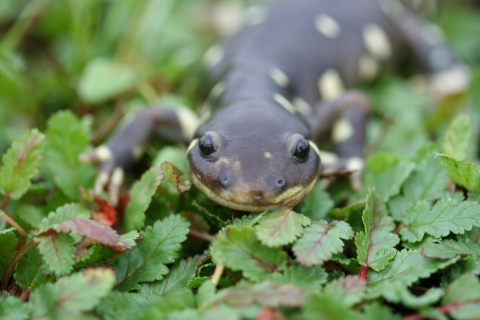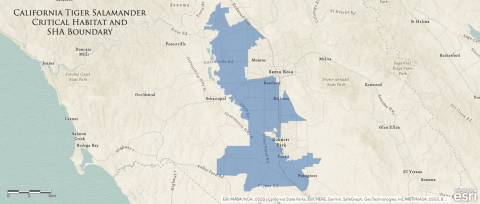Sonoma County in northern California is a wine lover's paradise. More than 60,000 acres of vineyards produce wines that are known around the world. Many of the wineries have been family-owned for several decades, and there’s a deep commitment among them to take care of the land for future generations while sustaining the local economy.
Along these lines, Sonoma County's winegrowers recently finalized a new Safe Harbor Agreement with the U.S. Fish and Wildlife Service that supports sustainable agricultural practices while protecting the Sonoma population of the California tiger salamander, an endangered species in Sonoma County.
A Salamander in Wine Country
It's not just the grapes that love the Mediterranean climate and fertile soil of Sonoma County. An incredible array of plants and animals evolved over the county's history to create a biodiverse landscape full of rare and unique species, including the Sonoma distinct population segment of the California tiger salamander.
California tiger salamanders are amphibians, which means they seek out wetlands, ponds and vernal pools to lay their eggs. Young salamanders start as legless, fish-like larvae that take at least 12 weeks to mature for life on land.
Once they leave the water, the salamanders seek animal burrows or other holes in the ground where they can stay moist and hide from predators. They live in these underground burrows most of the year and only come out to breed in the late winter after their breeding ponds have been filled by seasonal rainfall. Some salamanders will travel up to 1.3 miles to find the nearest breeding pond.
California tiger salamander habitat has declined in recent years due to housing development across the Santa Rosa Plain and ongoing drought. Because of these threats, the U.S. Fish and Wildlife Service listed the Sonoma population of California tiger salamander as endangered in 2003.
Safe Harbor Agreement: Balancing Conservation with Agriculture
When a local economy depends on agriculture, listing a species does not go unnoticed. Any farming operation causes some amount of disruption to the land and soil that could put species like salamanders at risk. In the case of grape vines, their productive lifespan doesn’t last forever, and they often need to be replanted after 25 to 35 years to maintain the same level and quality of harvest.
To reduce the risk of adversely affecting Sonoma County salamanders and violating the Endangered Species Act, in 2019, Santa Rosa Plain winegrowers, Sonoma County Farm Bureau, SAVE, North Bay Water District and U.S. Fish and Wildlife Service worked together to develop a Safe Harbor Agreement (SHA) that supports the wine industry and the salamander. Winegrowers that enroll in the SHA agree to follow agricultural best management practices while performing vineyard maintenance and replanting existing vineyards. These practices—such as preserving gopher burrows, only mowing between vines during certain months, and avoiding destruction of wetlands—are environmentally sustainable, preserve salamander habitat, and contribute to the health of the land as much as the health of the vines. In exchange for creating or protecting salamander habitat, participating wine growers will have assurances from the U.S. Fish and Wildlife Service that vineyard activities covered in the agreement can continue without requiring additional ESA-related permits. Each participating winegrower commits to a 10-year period, after which members can re-enroll for another 10 years.
Safe Harbor Agreements are one of the many tools the Service uses when working with private landowners to find balance between agriculture and species recovery. With the support of partners like winegrowers in Sonoma County, the California tiger salamander will remain part of the county’s rich biodiversity and long agricultural history.
More information about how to join the California Tiger Salamander Safe Harbor Agreement can be found on the Sonoma County Farm Bureau’s website or by contacting them via email at compliance@sonomafb.org.
To learn more about Safe Harbor Agreements in general, please visit the Service's topic page.
Partners Behind the Safe Harbor Agreement
Mike Martini, Sonoma Alliance for Vineyards and the Environment
“When partners can come together to create something like the Safe Harbor Agreement, it makes me optimistic. We’ve created policy that makes sense and given ourselves a road map for moving forward. I hope this leads to a whole series of other opportunities to create public-private partnerships and policies that allow for a vibrant economy while taking care of the environment and keeping the very special place we call home the very special place it is.”
Katie Jackson, Jackson Family Wines
“This Safe Harbor Agreement is a wonderful example of collaboration between private landowners and the U.S. Fish and Wildlife Service. It’s important because it’s allowing farmers to continue to farm their vineyards but to do so in a way that is conducive to supporting critical habitat for the California tiger salamander. It's very meaningful to me because I work on sustainability for my family’s business. It’s wonderful when business and conservation can align, and there can be benefits to both. The collaboration between the farmers and the agencies has been incredible.”
Ryan Olah, U.S. Fish and Wildlife Service
“This Safe Harbor Agreement is an important step in helping to recover Sonoma County's California tiger salamander population. The biggest threat to the species is losing habitat where they can breed and disperse. The County’s winegrowers are in a special position to help the salamander recover because they take care of much of the salamander’s habitat in the Santa Rosa Plain. When winegrowers build breeding ponds, those ponds will be protected and able to support the salamander’s recovery in perpetuity.”
Robin Bartholow, Sonoma County Farm Bureau
“We are so happy to be part of this Safe Harbor Agreement in partnership with the U.S. Fish and Wildlife Service, the North Bay Water District, SAVE and the Farm Bureau. Our proud and hard-working farming community has been here for decades, for centuries really. Our farmers grow food and wine not just for Sonoma County, but for the world. Their job isn’t just their job; they actually live where they work, so taking care of where they live is really important to them. The Safe Harbor Agreement is something that we've come together to create that helps the environment and takes care of Sonoma County's farmland.”
Nick Frey, Balletto Vineyards
“We’re pleased to have the Safe Harbor Agreement so that when we have to replant our vineyards, we have guidelines on how to go about that. It adds certainty to our business, and that’s always important to a farmer. We’ve been practicing sustainable farming methods for decades and although we haven’t seen California tiger salamanders on our property yet, we are hopeful that they will arrive once we implement the Agreement’s new guidelines specific to the salamander.”












